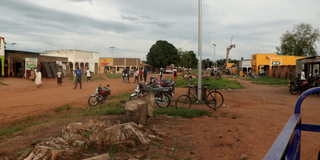Obongi locals left in the dark

Obongi Town. The entire district is not connected to electricity. PHOTO | FELIX WAROM OKELLO
What you need to know:
- Locals rely on solar or generators to power their homes, fridges, lighting, charge phones and operate video halls.
It’s 7:30am and energetic men are trickling in from River Nile to a landing site with all kinds of fish headed to fish markets in Obongi District.
Women at the landing site patiently wait for the fish to be brought to them before they begin smoking it.
“People like eating fresh fish but we cannot keep them for even a day because we have no power,” Ms Sauda Amviko, a fish dealer, with 34 years of experience, tells Sunday Monitor, adding that she loses about Shs500,000 in a week when unable to pull off the food preservation.
A sharp pang of regret rocks Ms Amviko who curses the fact that Obongi “might be the only district in Uganda without electricity connection.” It, she adds, is “as if we do not pay taxes.”
According to Uganda Bureau of Statistics’ 2020 data set, Obongi has 49,100 locals and 120,000 refugees. None has been connected to the grid since the district was carved out of Moyo in July 2019.
Obongi is a hub for fish and it serves neighbouring Adjumani and Moyo in Uganda as well as Nimule and Kajo Keji in South Sudan. Maize and sunflower milling could also be a viable income source if some form of energy can allow processing machines to roar.
According to a 2021 survey by Uganda Investments Authority (UIA), the district is a hub for agriculture (cassava, sim-sim and cotton), fishing, livestock (milk and beef) and retail trade.
It also has potential for commercial fruit growing and processing, quarrying and mining, financial services, real estate development, sports tourism along the River Nile and apiculture. All these activities need one thing—an adequate and stable power supply.
Connections to the grid could be pulled off in three ways. One is from Okubani Trading Centre in Yumbe District—30 kilometres from Obongi town. Two is from Moyo Town through Palorinya Sub-county, about 61 kilometres. The third option is from Adjumani over the River Nile, about 76 kilometres.
Energy poverty
The Electricity Connections Policy (ECP) developed by the government to address the challenge of low connection rates is of little value to Obongi residents. The policy set itself a target of ensuring a 60 percent level of access to the grid for Uganda by 2027, with annual connections increasing from the current average of 70,000 to 300,000.
Obongi longs for its energy poverty issues to be addressed decisively. A section of the street in its town is lit by solar power that was only recently installed. Locals rely on solar or generators to power their homes, fridges, lighting, charge phones and operate video halls.
“Much as I earn from phone charging using my solar, it would be better if we are connected to electricity because it is a more reliable source of power,” Mr George Asiku, a dealer in phones and accessories, tells us, adding, “People need to have their phones on most times either for businesses or to inform people about who is sick at home. So, if the phones are off because of no power, it affects people.”
Grim outlook
Obongi Health Centre IV that is supposed to be upgraded to a district hospital has also been caught in the energy poverty crosshairs. It mainly relies on solar and generators, both of which are costly to maintain. Owing to this, ailments that require surgery are referred to Moyo Hospital, Yumbe Hospital or Arua Regional Referral Hospital.
At dusk, security concerns also surge to the fore. Mr Emmanuel Mawa tells Sunday Monitor that last November witnessed a spike in “thefts and burglaries … because most areas are dark.”
“The E-systems in local governments, schools, health centres need adequate electricity. Several businesses in Obongi is crippled because of no power,” Dr George Bhoka, the Obongi County lawmaker, says, adding: “We had to put fuel for surveyors to carry out surveys for electricity. How can power lines be prioritised for Nimule when the people here are not yet connected to [the grid]?”
Mr Abdu Natwine, the assistant commissioner in-charge of electricity supply at the Energy ministry, says about 120MW of power will be generated from Nebbi and Muni sub-stations in a rural electrification undertaking.
“We have managed to get funds from the World Bank to prioritise power in rural areas by 2030. We hope that the $600 million loan requested by Parliament will enable us to achieve rural electrification. We want to connect over 1 million power consumers using this money,” he reveals.
Power supply
According to the Afrobarometer 2021 report, only one in four Ugandans (26 percent) live in households that are actually connected to the grid. Urban residents (67 percent) are five times likely to have an electricity connection as their rural counterparts (13 percent).




